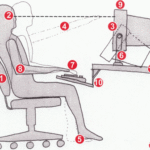Study Says In-Person Reinforcement of Training Increases Its Effectiveness

Safety professionals devote a lot of their time to safety training. A recent study from researchers at the Institute for Work & Health (IWH) has found that providing ‘enhanced training’ to reinforce what workers and supervisors were originally taught improves the effectiveness of their safety training.
The field study was conducted in five multi-site organizations over a year and focused on office ergonomics training, which workers could take in one of four ways:
- In-person training only (a 90-minute session led by a trainer in a classroom setting)
- Online training only (nine 10-minute computer-based modules completed at participants’ desks)
- In-person plus enhanced training
- Online plus enhanced training.
Both in-person and online training delivered the same content in about the same amount of time.
The ‘enhanced training’ was designed to reinforce the knowledge and skills of workers and supervisors and increase their confidence in their own ability to successfully identify problems and implement solutions. It was delivered three to six months after the in-person or online training and included three 30-minute sessions for workers and one 60-minute session for managers and supervisors, all delivered in person.
The enhanced training sessions for workers coached them in how to partner to identify and address the ergonomic hazards of office workstations (called ‘ergo-buddy assessments’). The supervisor session explained how the ergo-buddy system works, the importance of being a role model and how to build a healthy computing culture.
IWH Senior Scientist Dr. Ben Amick, who led the study, says ‘Our study shows that both in-person and online training improve worker practices and postures. However, both methods are significantly more effective when followed up by enhanced training.’
Amick explained that over time, those who received the enhanced ergonomics training on top of either the in-person or online safety training had significantly:
- Higher self-efficacy
- Lower postural risk
- Greater likelihood of having properly configured and adjusted workstations.
Bottom line: The same health and safety content can be delivered either in person or online and both will improve worker practices to about the same degree, says Amick. But adding in-person sessions will significantly increase the effectiveness of both methods of training delivery.
In other words, OHS training for workers is substantially more effective when follow-up sessions help them confidently apply their newly learned skills and teach supervisors how to support them in doing so.
OHS Insider Resources
Go to the OHS Insider‘s Training Compliance Centre for more information and tools on safety training, including the training requirements for workers and supervisors under the OHS laws, training checklists and recorded webinars on safety training, such as holding the perfect safety meeting.
And go to SafetySmart for tools to help you manage and reinforce training, such as safety talks and quizzes.